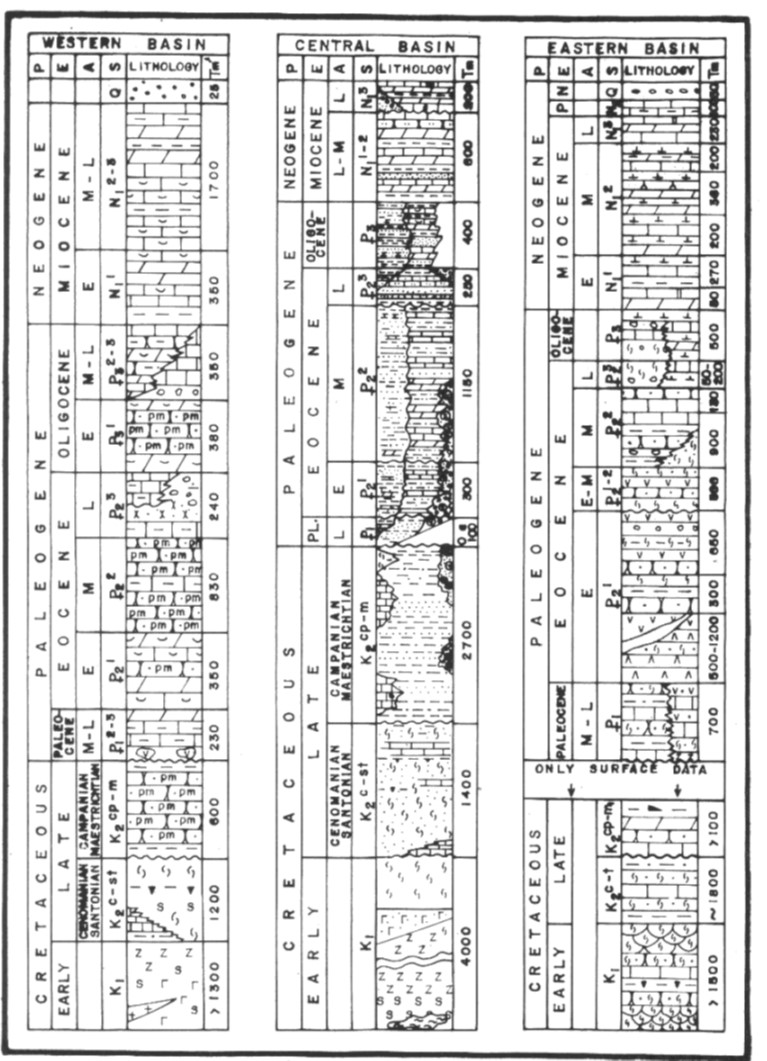
Тип бассейна:
Подтип бассейна:
Класс бассейна:
Возраст бассейна:
Тип полезных ископаемых:
Геологический возраст начало:
Геологический возраст конец:
Площадь: 16625.16 км²
THE SOUTHERN PROVINCE
This Province occupies practically the whole onshore area, and extends to adjacent offshore areas to the south. It is composed of several basins formed during the Upper Cretaceous—Tertiary.
Oilfields have so far only been discovered in the Central Basin, in which most wells have been drilled.
The Province is composed of the Western (Los Palacios, Vegas and Mercedes). Central (Central and Ana Maria) and Eastern (Cauto, Nipe and Guantanamo) Basins. Sediments in the Western and Central Basins were deposited from the Upper Cretaceous (Campanian) onwards, while those in the Eastern Basin date from the Lower Eocene. Terrigenous-carbonate sedimentation took place in subsiding areas of the extinct volcanic arc in the Cretaceous and Paleogene, probably in a “piggyback” type basin.
Stratigraphic sections corresponding to the different basins of this province are shown in Fig. 2.

Fig.2. Stratigraphic columns for the cretaceous-Tertiary basins in the Southern Province
The Central Basin is composed of two depocentres (Ana Maria and Central), the first being located offshore in the Caribbean Sea. The Basin is composed of a NE-striking graben, bounded by deep faults (fig.3). On a gravimetric map, it is represented by a minimum (-36 mgal) bounded by strong gradient zones, and its dimensions are 80 kms long and 25 - 50 kms wide. The basin is divided into fault blocks, which are thicker in the basin centre than on the margin.

Fig.3. The Central Basin, Southern Province: (a) general cross-section; (b) structural map; (c) geological section of the Cristales oilfield
Organic material in Central Basin sediments is sapropelic, but overall concentrations are much lower than in the Northern Province (Table 1), the highest values being present in syn-orogenic deposits (of late Upper Cretaceous - early Middle Eocene age), which are here considered to be source rocks. However, it has been calculated that there is insufficient organic matter present in the orogenic sediments within the “oil window” to produce the hydrocarbon reserves present. According to geochemical data (Table 1), and the organic matter and bitumen contents in rocks, the volume of hydrocarbons recovered (totalling some 2MM tons) was generated both from Upper Cretaceous sources within the basin, and additional sources. This idea agrees with the model presented in this paper, with the Placetas and Camajuani TSUs underlying the frontal overthrust volcanic arc, and migration occurring along faults in a NE-SW direction.
Table 1. Content of bitumen and organic carbon in Northern and Southern Province cores
|
Sequence |
Organic Carbon Contents % |
Scattered Bitumen Contents % |
|
Northern Province |
||
|
Lower-Middle Jurassic |
3,1 |
0,029 |
|
Upper Jurassic-Aptian |
3,89 |
0,08 |
|
Albian-Turonian |
0,90 |
0,04 |
|
Late Middle Eocene and Youngee |
0,12 |
0,04 |
|
Southern Province (k2-Tertiary Basins) |
||
|
Precampanian (Pre-orogenic) |
0,45 |
0,04 |
|
Campanian-Meddle (Syn-orogenic) |
0,60 |
0,12 |
|
Post Meddle Eocene (Post-orogenic) |
0,50 |
0,08 |
The rest of the Southern Province
No oilfields have been found in the Western and Eastern Basins of the Southern Province. However, oil shows have been reported in wells and at the surface in keys in the south, associated with mud volcanoes (Tenreyro and Echevarria, 1986).
Seismic reflection lines in the three basins of the province give a good structural picture, including the upper part of the island-arc association (Hernandez, 1986), in which sedimentary thicknesses of 5-6 kms have been identified.
Data source: Oil and gas exploration in Cuba. G. Echevarria-Rodriguez, G. Hernandez-Perez, J. O. Lopez-Quintero, J. G. Lopez-Rivera, R. Rodriguez-Hernandez, J. R. Sanchez-Arango, R. Socorro-Trujillo, R. Tenreyro-Perez and J. L. Yparraguirre-Pena. Journal of Petroleum Geology, vol. 14 (3), July 1991, pp. 259-274
Следующий Бассейн: Delaware